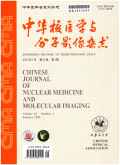骨代谢生化指标与女性年龄及骨密度的相关性
Correlation between age-related changes of osseous metabolic markers and bone mineral density in females
摘要目的:探讨女性骨代谢生化指标与年龄及骨密度的关系。方法选取不同年龄组女性309例(25~84岁),以电化学发光法检测患者血清总Ⅰ型胶原氨基端延长肽( TPⅠNP )、β胶原特殊序列(β?CTX)的含量,ELISA检测患者血清25?羟基维生素D(25?OH?VitD)、抗酒石酸酸性磷酸酶5b(TRACP?5b),采用双能X线(DXA)骨密度仪测其股骨颈及腰椎L1~4部位的骨密度(BMD)。将309例患者根据年龄和BMD进行分组,比较组间骨代谢生化指标差异,采用SPSS 17?0软件对数据进行两样本t检验、方差分析或χ2检验。结果血清TPⅠNP、β?CTX在45~54岁组高于在35~44岁组:(55?63±19?24)比(40?90±14?63)μg/L,(597?10±198?70)比(404?79±147?22) ng/L(t=4?156、5?319,均P<0?01),随后随年龄增长呈下降趋势;血清25?OH?VitD 随年龄增长呈下降趋势;血清TRACP?5b在45~54岁组高于在35~44岁组(t=5?934,P<0?01),55~64岁组进一步升高至(5?05±1?63) U/L,后随年龄增长呈下降趋势。骨量减少组(100例)和骨质疏松组(111例)血清TPⅠNP、β?CTX、25?OH?VitD、TRACP?5b与骨量正常组(98例)相比差异均具有统计学意义( F=225?908、253?208、252?927、313?265,均P<0?01)。以BMD结果为“金标准”,4项骨生化指标对于BMD异常的诊断特异性和阳性预测值均大于95%,血清25?OH?VitD、TRACP?5b的灵敏度[91?47%(193/211)、88?15%(186/211)]高于血清TPⅠNP[65?40%(138/211);χ2=42?381、30?621,均P<0?01]和β?CTX的灵敏度[51?66%(109/211);χ2=82?164、66?783,均P<0?01]。阴性预测值的比较亦有类似结果(χ2:15?367~38?126,均P<0?01)。结论女性骨代谢生化指标均与年龄及BMD存在密切相关性,检测骨代谢生化指标在早期诊断骨质疏松中非常重要。
更多相关知识
abstractsObjective To investigate the age?related changes of osseous metabolic markers and their relationships to bone mineral density ( BMD) in females. Methods A total of 309 females with differ?ent ages (25-84 years) were enrolled. The total collagen type I amino?terminal extension peptide (TPⅠNP) and beta collagen specific sequences (β?CTX) were measured by electrochemical luminescence method. 25?hydroxy vitamin D( 25?OH?VitD) and tartrate?resistant acid phosphatase?5b( TRACP?5b) were measured u?sing ELISA. BMD of femoral neck, lumbar spine 1-4 were measured with a bone densitometer ( GE Lunar Prodigy dual energy X?ray absorptiometry, DXA). The differences among different age and BMD groups were compared by two?sample t test, one?way analysis of variance,χ2 test with SPSS 17.0 software. Results The serum TPⅠNP , β?CTX levels in the 45-54 years group were higher than those in the 35-44 years group:(55.63±19?24) μg/L vs (40.90±14.63) μg/L, (597.10±198.70) ng/L vs (404.79±147.22) ng/L ( t=4.156, 5.319, both P<0.01) , and decreased slightly with increasing age. The serum 25?OH?VitD level decreased with increasing age. The serum TRACP?5b in the 45-54 years group increased significantly com? pared to that in the 35-44 years group (t=5.934,P<0.01); and it reached the highest level of (5.05± 1?63) U/L in the 55-64 years group, then decreased slightly. The serum levels of TPⅠNP,β?CTX,25?OH?VitD,TRACP?5b in osteopenic and osteoporosis groups were significantly different from those in the nor?mal group ( F=225?908, 253.208, 252.927, 313.265, all P<0.01) . The specificities and positive predic?tive values of all four osseous metabolic markers were all over 95% for the diagnosis of abnormal BMD. The sensitivities of both serum 25?OH?VitD and TRACP?5b levels were higher than those of TPⅠNP ( 91. 47%(193/211), 88?15%(186/211) vs 65.40%(138/211); χ2=42.381, 30.621, both P<0.01) and β?CTX (51.66%(109/211); χ2=82.164, 66.783, both P<0.01). Negative predictive values of both serum 25?OH?VitD and TRACP?5b levels were higher than those of TPⅠNP(χ2=23.103, 15.367, both P<0.01) andβ?CTX(χ2=38.126, 28.514, both P<0.01) . Conclusions The osseous metabolic markers might be close?ly related to the changes of BMD and age in females. It was important to measure the bone metabolism mark?ers in the early diagnosis of osteoporosis.
More相关知识
- 浏览305
- 被引9
- 下载104


相似文献
- 中文期刊
- 外文期刊
- 学位论文
- 会议论文



 换一批
换一批 换一批
换一批



